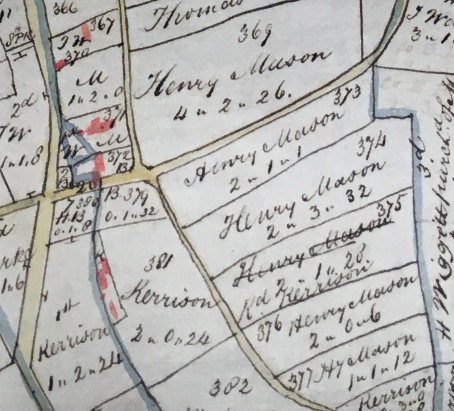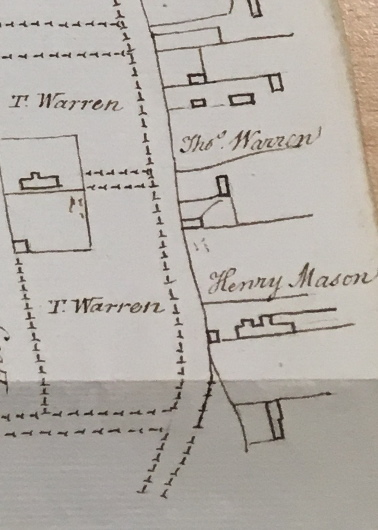Church Path
Before it was ‘put by and discontinued‘ by the Great Ellingham Inclosure Act of 1799, a footway known as Church Path, which began in the centre of the village, concluded at an inclosure called ‘Green Way’, near to what was then (or later to become) Shrugg’s Lane which itself crossed Long Street.

Extract from 1802 Map of Great Ellingham. Original held at Norfolk Record Office. Russell James Colman Plans.
Cat. Ref. C/Ca 1/84. With kind permission of NRO
House later known as White House Farm
The numbering of parcels of land used in the schedules to a Particulars & Valuation of Great Ellingham of 1800 corresponds with the numbering used on an 1802 Map of Great Ellingham.
Accordingly, we can tell from the Particulars & Valuation that an inclosure called ‘Green Way Piece’ (and numbered 373 on the above extract from the 1802 Map) was owned by Henry Mason and then by John Wiggett. With north being to the top of the above map, Shruggs Lane abuts the northern boundary of the field numbered 373, and passes near to the inclosures numbered 379, 272 and 738 before joining Long Street.
The extract of the 1802 Map also identifies other parcels of land then owned by John Wiggett (previously owned by Henry Mason):
- 369 Home Close
- 373 Green Way Piece
- 374 Hazel Pightle
- 376 Upper Sinks
- 377 Lower Sinks
- 382 Stony Piece
- 371 House, Outbuildings, Barn, Stable, Yard, Garden & Hempland
In addition, John Wiggett also owned allotments on Town Green, Hyrne Common and the Burying Ground Common.
The House with associated buildings and land referred to at number 371 on the map, was later known as White House Farm. For ease of reference in this blog, I will refer to the property identified on the 1802 Map at 371 as ‘White House Farm’.
Henry Mason

Extract from 18th Century Map. Town Green, Hyrne and Broad Commons in Great Ellingham held at Norfolk Record Office.
Cat. Ref. MC2213/113, 941X7. With kind permission of NRO.
This extract from an earlier 18th century Map also identifies the dwelling in Long Street owned by Henry Mason.
At No.46 of the Statement of Claims to the Commissioners in relation to the Great Ellingham Inclosures c.1799, Henry Mason claimed:
One messuage, wasted, one messuage and 22 acres of land occupied by __________ Of which one messuage, 7 acres 1 rood and 20 perches are copyhold of Ellingham Hall; 3 roods 20 perches of Ellingham Rectory; 1 rood 20 perches of Bury Hall; and two roods of Buckenham Castle Outsoken
In addition, Henry Mason claimed various rights benefiting his property over the common and waste lands in the village.
The Manor Court Books for Buckenham Castle Outsoken, tells us that Henry Mason, a farmer of Great Cressingham, was admitted as a copyhold tenant of two separate parcels of land in Great Ellingham (amounting to two roods) of the Manor of Buckenham Castle Outsoken in 1795 (or thereabouts) from Richard Palmer, a cordwainer of Attleborough.
In the same Manor Court Books, the same Richard Palmer was later referred to as a yeoman of Great Ellingham. Further, Richard Palmer himself had acquired these two pieces of land from Cornelius Carter in 1794 (who, in turn, had inherited land from his father, Jacob Carter in 1788).
We know that at the time of the Great Ellingham Inclosures Act, 1799, Henry Mason owned White House Farm, including the two parcels of copyhold land of the Manor of Buckenham Castle Outsoken. However, I cannot say for certain whether or not White House Farm itself was owned previously by Richard Palmer, Cornelius Carter or Jacob Carter, but it is quite possible.
I do not know whether Henry Mason lived at White House Farm. Unfortunately, Mason’s claim to the Commissioners in the ‘Statement of Claims’ mentioned above, does not provide us with the name of the occupier – either as himself or the name of a tenant.
John Wiggett
According to the Manor of Buckenham Castle Outsoken Court Books, John Wiggett was admitted as a copyhold tenant of the two roods of copyhold land in this Manor at a Manor Court held on 22 January, 1801 on the ‘surrender’ of Henry Mason. John Wiggett was said to be a farmer of East Bradenham.
We can be certain that the ownership of White House Farm and the other parcels of land also transferred to John Wiggett as the Particulars & Valuation c.1800 of Great Ellingham (again in relation to the inclosures), lists the owner of White House Farm (referred to in the document as inclosure numbered ‘371 on the map’) and the other parcels of land as John Wiggett. The document also indicates that the previous owner was ‘Mason’.
The same document also suggests that John Wiggett occupied White House Farm and the other pieces of land.
Robert Mack
Around 1812, Robert Mack, a farmer of Banningham, Norfolk, purchased White House Farm, as well as the pieces of land once owned by Henry Mason, from John Wiggett.
The Manor Court Books for Buckenham Castle Outsoken tells us that Robert Mack was admitted copyhold tenant of the Manor around 1812 in respect of the same two roods of copyhold land once held in succession by Jacob Carter, Cornelius Carter, Richard Palmer, Henry Mason and then John Wiggett.
A Survey of Great Ellingham of 1817-1819 lists Robert Mack as the owner and occupier of White House Farm, and the same parcels of land once owned by Henry Mason. However I am uncertain whether Robert Mack did in fact live at the property. When he made his last Will and Testament on the 19 October, 1830, Robert Mack was described as a gentleman of North Walsham (but late of Banningham). Robert Mack died on the 24th June, 1837.
Thomas Rix
Following Robert Mack’s death, the Manor Court Books for Buckenham Castle Outsoken tells us that in January 1839, Thomas Rix was admitted a copyhold tenant of the same two roods of copyhold land which were once owned consecutively by Jacob Carter, Cornelius Carter, Richard Palmer, Henry Mason, John Wiggett and Robert Mack.
Thomas Rix, a farmer of Great Ellingham, purchased the two roods of copyhold land from the executor of Robert Mack deceased, as well as other parcels of copyhold land of the same Manor which Robert Mack had purchased from the executors of the late Hannah Browne.
I am unsure as to how long Thomas Rix owned White House Farm. A notice appeared in the Norwich Mercury of 28th September, 1844 advising of an auction sale at Great Ellingham on the 3rd October of the live and dead farming stock and effects of Mr Thomas Rix who ‘has left his farm’.
The stock included two bay cart mares, good road waggon, tumbrel, gig, harrows, barn implements, dairy and brewing utensils. A catalogue of all the items for sale was available from the auctioneers, Glasspoole & Standley of Wymondham.
However, the 1855 Register of Electors for Great Ellingham reveal Thomas Rix as having a freehold house and land in Long Street. Thomas Rix may not have left White House Farm after all or, perhaps, he may have occupied another property in Long Street.
Sources:
1802 Russell James Colman Plans. Great Ellingham. Catalogue Ref. C/Ca 1/84.
1799-1842 F W Horner, Records of the Surveyors to Commissioners for Inclosure in Parishes in Norfolk and Suffolk. Great Ellingham (Act 1799). Norfolk Record Office. Catalogue Ref: NRO, BR 90/2
1800 Inclosure Commissioner’s Particulars and Valuation, Great Ellingham. Norfolk Record Office. Catalogue Ref: NRO, MC 2213/119
1753-1847 Manor of Buckenham Castle, Lathes, Close and Priory. Court Book. Norfolk Record Office. Catalogue Ref: MC 1833/8 -MC 1833/16. Also available at https://www.familysearch.org/
18th Century. Maps. Town Green, Hyrne and Broad Commons in Great Ellingham. Norfolk Record Office. Catalogue Ref: MC 2213/113, 941×7.
nd [19th century]. Inclosure Award extract. Great Ellingham regarding footpaths etc. Catalogue Ref: MC 2213/123
England, Norfolk Register of Electors, 1832-1915,” database with images, FamilySearch (https://familysearch.org/ark:/61903/3:1:S3HT-6M4S-H3J?cc=1824705&wc=MX69-X38%3A161034801%2C161034802%2C161048701 : 21 May 2014), Norfolk > Eastern division > 1855 > image 138 of 146; Record Office, Central Library, Norwich. Accessed 16 October 2020
Norwich Mercury 28th September 1844